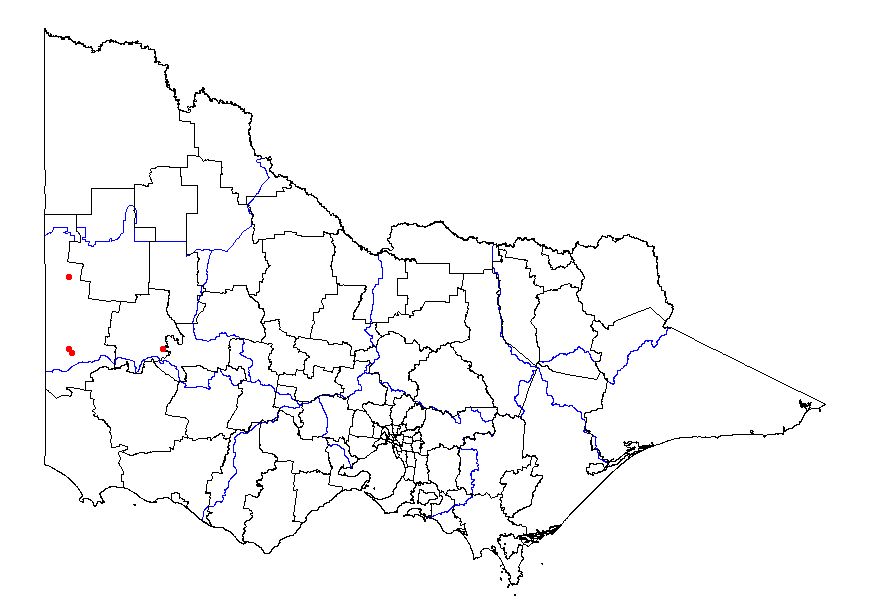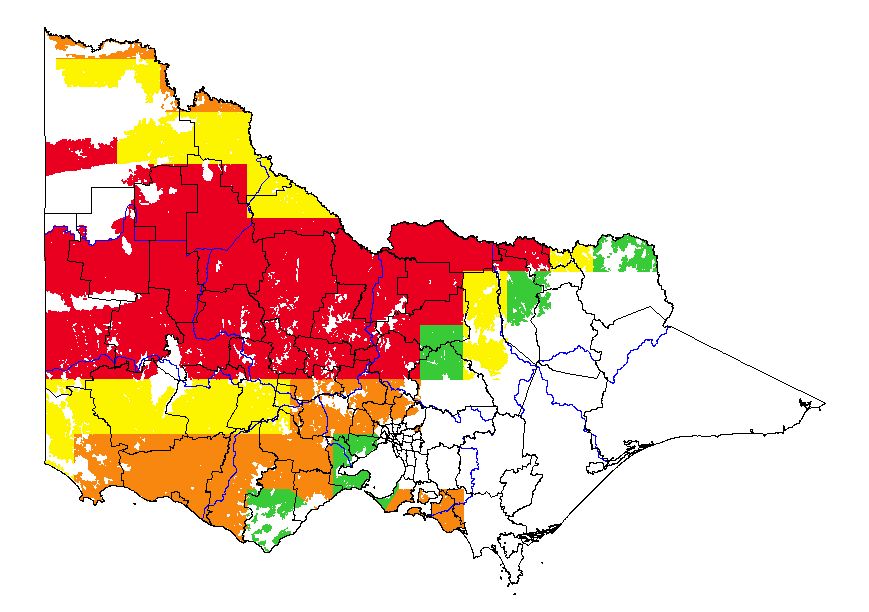Glaucous star thistle (Carthamus leucocaulos)
Present distribution
|  Map showing the present distribution of this weed. | ||||
| Habitat: A weed of cultivated land, pasture, roadsides and disturbed areas (Parsons & Cuthbertson 2001 and Richardson, Richardson & Sheperd 2006) | |||||
Potential distribution
Potential distribution produced from CLIMATE modelling refined by applying suitable landuse and vegetation type overlays with CMA boundaries
| Map Overlays Used Land Use: Broadacre cropping; horticulture; pasture dryland; pasture irrigation Broad vegetation types Coastal grassy woodland; grassland; plains grassy woodland; riverine grassy woodland; wimmera / mallee woodland Colours indicate possibility of Carthamus leucocaulos Sm.infesting these areas. In the non-coloured areas the plant is unlikely to establish as the climate, soil or landuse is not presently suitable. | 
|
Impact
QUESTION | COMMENTS | RATING | CONFIDENCE |
| Social | |||
| 1. Restrict human access? | Can restrict the movement of stock, with prickles would restrict the movement of individuals (Parsons & Cuthbertson 2001). | ml | mh |
| 2. Reduce tourism? | Prickly plant may restrict the use of some areas and alter the aesthetics, however no evidence of this has been reported. | ml | l |
| 3. Injurious to people? | Has prickles (Parsons & Cuthbertson 2001). | mh | mh |
| 4. Damage to cultural sites? | May alter aesthetics, no evidence reported. | ml | l |
| Abiotic | |||
| 5. Impact flow? | Terrestrial species | l | m |
| 6. Impact water quality? | Terrestrial species | l | m |
| 7. Increase soil erosion? | Unknown | m | l |
| 8. Reduce biomass? | Annual species that invades disturbed areas (Parsons & Cuthbertson 2001). May cause direct replacement. | ml | mh |
| 9. Change fire regime? | Fire characteristics unknown. However the plant doest die after flowing leaving standing biomass at the end of summer (Parsons & Cuthbertson 2001). May have some minor impact on fire intensity through altering biomass or timing by altering curing patterns of the vegetation. | ml | m |
| Community Habitat | |||
| 10. Impact on composition (a) high value EVC | EVC= Plains Grassland (E); CMA= Wimmera; Bioreg= Wimmera; VH CLIMATE potential. Can form dense patches, therefore may cause some displacement (Parsons & Cuthbertson 2001). | ml | mh |
| (b) medium value EVC | EVC= Riverine Grassy Woodland (D); CMA= North Central; Bioreg= Victorian Riverina; VH CLIMATE potential. Can form dense patches, therefore may cause some displacement (Parsons & Cuthbertson 2001). | ml | mh |
| (c) low value EVC | EVC= Shrubby Riverine Woodland (LC); CMA= Mallee; Bioreg= Murray Mallee; VH CLIMATE potential. Can form dense patches, therefore may cause some displacement (Parsons & Cuthbertson 2001). | ml | mh |
| 11. Impact on structure? | Can form dense patches, therefore may cause some displacement (Parsons & Cuthbertson 2001). | ml | mh |
| 12. Effect on threatened flora? | Unknown | mh | l |
| Fauna | |||
| 13. Effect on threatened fauna? | Unknown | mh | l |
| 14. Effect on non-threatened fauna? | Can reduce food for grazing species by restricting access (Parsons & Cuthbertson 2001). | ml | mh |
| 15. Benefits fauna? | May provide some temporary shelter, because of its prickles. | h | m |
| 16. Injurious to fauna? | Has prickles (Parsons & Cuthbertson 2001). | mh | mh |
| Pest Animal | |||
| 17. Food source to pests? | Not grazed by domestic stock (Parsons & Cuthbertson 2001). | l | m |
| 18. Provides harbor? | May provide some temporary shelter, because of its prickles. | m | l |
| Agriculture | |||
| 19. Impact yield? | Capable of forming dense patches which can restrict the movement of stock and reduce the effective production area (Parsons & Cuthbertson 2001). | ml | mh |
| 20. Impact quality? | Can be a contaminate in grain crops and wool (Parsons & Cuthbertson 2001). | mh | mh |
| 21. Affect land value? | Unknown. | m | l |
| 22. Change land use? | Unknown. | m | l |
| 23. Increase harvest costs? | Can restrict the movement of animals, and interfere with machinery during harvesting, causing blockages and damaging the machinery (Parsons & Cuthbertson 2001). | h | mh |
| 24. Disease host/vector? | No evidence of this reported. | l | m |
Invasive
QUESTION | COMMENTS | RATING | CONFIDENCE |
| Establishment | |||
| 1. Germination requirements? | Germination occurs in autumn and into winter (Parsons & Cuthbertson 2001). | mh | mh |
| 2. Establishment requirements? | Unknown | m | l |
| 3. How much disturbance is required? | Described as a weed of disturbed environments (Parsons & Cuthbertson 2001). | ml | mh |
| Growth/Competitive | |||
| 4. Life form? | Annual herb (Parsons & Cuthbertson 2001). | l | mh |
| 5. Allelopathic properties? | None described | l | m |
| 6. Tolerates herb pressure? | Not grazed (Parsons & Cuthbertson 2001). | h | mh |
| 7. Normal growth rate? | Can grow to a height of 1m in a couple of months (Parsons & Cuthbertson 2001). | mh | mh |
| 8. Stress tolerance to frost, drought, w/logg, sal. etc? | Unknown | m | l |
| Reproduction | |||
| 9. Reproductive system | Reproduces sexually, producing seed (Parsons & Cuthbertson 2001) | ml | mh |
| 10. Number of propagules produced? | An average of 9.4 seeds are produced per head (Estilai & Knowles 1978). From an image a single plants are capable of producing more than 10 seed heads (Parsons & Cuthbertson 2001). | ml | mh |
| 11. Propagule longevity? | Unknown. | m | l |
| 12. Reproductive period? | Annual species (Parsons & Cuthbertson 2001). | l | mh |
| 13. Time to reproductive maturity? | Annual species (Parsons & Cuthbertson 2001). | h | mh |
| Dispersal | |||
| 14. Number of mechanisms? | Can become entangled in wool, dispersed externally on animals (Parsons & Cuthbertson 2001). | ml | mh |
| 15. How far do they disperse? | Described as being dispersed “considerable distances” (Parsons & Cuthbertson 2001). Therefore some seeds will be dispersed greater than one kilometre. | mh | mh |
References
Estilai A. & Knowles P.F. (1978) Relationship of Carthamus leucocaulos to other Carthamus species (Compositae). Canadian Journalof Genetics and Cytology. 20: 221-233.
Parsons W.T. & Cuthbertson E.G. (2001) Noxious weeds of Australia, 2nd ed., CSIRO Publishing, Collingwood.
Richardson F.J, Richardson R.G. & Sheperd R.C.H. (2006) Weeds of the South-East, An identification guide for Australia. R.G. and F.J. Richardson. Meredith, Victoria, Australia.
Global present distribution data references
Australian National Herbarium (ANH) 2006, Australia’s Virtual Herbarium, Australian National Herbarium, Centre for Plant Diversity and Research, viewed 25 Sep 2006 , http://www.anbg.gov.au/avh/
Calflora: Information on California plants for education, research and conservation. [web application]. 2006. Berkeley, California: The Calflora Database [a non-profit organization] viewed 25 Sep 2006, http://www.calflora.org/ .
Global Biodiversity Information Facility (GBIF) 2006, Global biodiversity information facility: Prototype data portal, viewed 25 Sep 2006, http://www.gbif.org/
Feedback
Do you have additional information about this plant that will improve the quality of the assessment?
If so, we would value your contribution. Click on the link to go to the feedback form.


